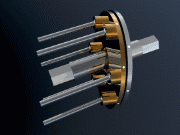Swashplate: Difference between revisions
No edit summary |
No edit summary |
||
| Line 1: | Line 1: | ||
{{Refimprove|date=September 2007}} |
{{Refimprove|date=September 2007}} |
||
[[Image:Swashplate anim metal.gif|thumb|200px|right|'''Swashplate animation.''' The rotating shaft and plate are shown in silver. The fixed plate is shown in gold and six shafts each take a reciprocating motion from points on the gold plate. The shafts might be connected to pistons in cylinders. Note the power may be coming from the shaft to drive the pistons as in a pump, or from the pistons to drive the shaft rotation as in an engine.]] |
[[Image:Swashplate anim metal.gif|thumb|200px|right|'''Swashplate animation.''' The rotating shaft and plate are shown in silver. The fixed plate is shown in gold and six shafts each take a reciprocating motion from points on the gold plate. The shafts might be connected to pistons in cylinders. Note the power may be coming from the shaft to drive the pistons as in a pump, or from the pistons to drive the shaft rotation as in an engine.]] |
||
A '''swashplate''' (also known as slant disk), invented by [[Anthony George Maldon Michell]] in [http://www.newcomen.com/wp-content/uploads/2012/12/Chapter-12-Anning.pdf 1917], is a device used in [[mechanical engineering]] to translate the motion of a rotating shaft into [[reciprocating motion]], or |
A '''swashplate''' (also known as slant disk), invented by [[Anthony George Maldon Michell]] in [http://www.newcomen.com/wp-content/uploads/2012/12/Chapter-12-Anning.pdf 1917], is a device used in [[mechanical engineering]] to translate the motion of a rotating shaft into [[reciprocating motion]], or vice versa. The working principles is similar to [[crankshaft]], [[Scotch yoke]], or wobble/nutator/Z-crank drives, in engine designs. It was firsly invented to replace crankshaft, hence known as crankless engine or mechanism. |
||
== Construction == |
== Construction == |
||
Revision as of 01:04, 17 July 2017
This article needs additional citations for verification. (September 2007) |

A swashplate (also known as slant disk), invented by Anthony George Maldon Michell in 1917, is a device used in mechanical engineering to translate the motion of a rotating shaft into reciprocating motion, or vice versa. The working principles is similar to crankshaft, Scotch yoke, or wobble/nutator/Z-crank drives, in engine designs. It was firsly invented to replace crankshaft, hence known as crankless engine or mechanism.
Construction
A swashplate consists of a disk attached to a shaft. If the disk were aligned perpendicular to the shaft, then rotating the shaft would merely turn the disk with no reciprocating (or swashplate) effect. But instead the disk is mounted at an oblique angle, which causes its edge to appear to describe a path that oscillates along the shaft's length as observed from a non-rotating point of view away from the shaft. The greater the disk's angle to the shaft, the more pronounced is this apparent linear motion. The apparent linear motion can be turned into an actual linear motion by means of a follower that does not turn with the swashplate but presses against one of the disk's two surfaces near its circumference. The device has many similarities to the cam.
The swashplate engine uses a swashplate in place of a crankshaft to translate the motion of a piston into rotary motion. Internal combustion engines and Stirling engines have been built using this mechanism.
The axial piston pump drives a series of pistons aligned coaxially with a shaft through a swashplate to pump a fluid.[1]
A helicopter swashplate is a pair of plates, one rotating and one fixed, that are centered on the main rotor shaft. The rotating plate is linked to the rotor head, and the fixed plate is linked to the operator controls. Displacement of the alignment of the fixed plate is transferred to the rotating plate, where it becomes reciprocal motion of the rotor blade linkages. This type of pitch control, known as cyclic pitch, allows the helicopter rotor to provide selective lift in any direction.
Nutating flowmeters and pumps have similar motions to the wobble of a swashplate, but do not necessarily transform the motion to a reciprocating motion at any time.
Active Electronically Scanned Array (AESA) radars are flat plates that can scan up to sixty degrees in any direction from directly ahead of them. By mounting an AESA radar on a swashplate, the swashplate angle is added to the electronic scan angle. The typical swashplate angle chosen for this application is 40 degrees so the radar can scan a total angle of 200 degrees out of 360.[2]
Notes
- ^ Harris et al
- ^ Gripen NG AESA Radar
References
- Harris,, R. M.,; Edge, K. A.; Tilley, D. G. (1993). "Predicting the behaviour of slipper pads in swashplate-type axial piston pumps". ASME WAM. New Orleans, LA, USA.: University of Bath Repository: 1–9.
{{cite journal}}: CS1 maint: extra punctuation (link) CS1 maint: multiple names: authors list (link)
External links
- YouTube video of a swashplate in action: [1]
